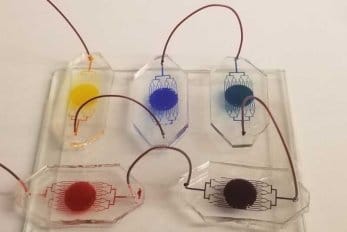Microfluidic-based devices for Point-Of-Care applications
Monitoring the environmental pollutants and disease diagnostics are the two hot subject matters in the point of care research. The goal is to develop portable devices that can reliably detect a contaminant or a pathogen at the desired place rather than sending the samples back to a central lab. However, tracking the chemicals in the environment in a fully integrated manner is challenging. Pathogen diagnosis also has its own challenges and each pathogen can be detected differently than the others. Microfluidics based devices for point-of-care applications have been showing promising results for both environmental monitoring of the microorganisms and chemicals as well as pathogen detection.
What are the characteristics of an ideal Point-Of-Care device?
In general, an ideal Point Of Care (POC) tool should have the following characteristics:
– High sensitivity: Often even a very low concentration of a chemical or microorganism can be deadly. For example, the maximum allowed concentration of E. coli in drinking water could be as low as 10 E. coli/100 mL. So, an ideal POC device should be highly sensitive to capture and detect very low amounts of the target component or pathogen.
– Real-time analysis: The whole point of a POC device is to be able to analyze the samples in real-time and at the point of care rather than only collecting the samples and sending them a main laboratory. The ideal POC tool should be able to process the sample fully and in real-time.
– Quick sample-to-result turnaround: The disadvantage of many of the conventional clinical or environmental tests is the long turnaround time. However, in the case of pathogens, a quick detection POC system enables the patient to benefit from early interventions and increase the survival rate. Also, in environmental applications such as water quality management systems, a rapid result can help to take the necessary actions as soon as possible to avoid the spreading of the toxin.
– Integrable: The technology needs to be integrable with various modalities such as a readout or a communication system. A wifi communication system allows remote controlling of the POC tool and can transfer the results to the researcher or the clinician in real-time
What are the advantages of using microfluidic chips in Point-Of-Care devices?
The unique features of microfluidic diagnostics chips such as modularity, portability, low reagent and sample consumption, and high sensitivity make these microchips suitable for point of care applications.
Microfluidics offers handheld chips that are integrable with magnetic, optical, electrical, and electrochemical modules. Magnetic modules can open/close valves in the chips or help in sample preparation. Electrical and optical sensors are very common as both actuators and readout systems. Electrochemical techniques such as electrochemical impedance spectroscopy (EIS) can easily be employed in the chip for extracting data. These microfluidic point-of-care chips are highly sensitive and are able to process very small amounts of samples. They can be modified or parallelized to analyze larger volumes if need be. Microfluidic devices are excellent choices for the rapid detection of both environmental pollutants such as heavy metals and microorganisms and human pathogens in Point Of Care (POC) applications. Microfluidics fabricated channels reduce the sample-to-result time significantly and omit the need for fully equipped laboratories at the point of care for real-time monitoring.
Microfluidic Point-Of-Care devices for environmental testing
Sample preparation

(USEPA photo by Shannon Bond)
The first step and a challenging step for microfluidic diagnostics POC chips is sample preparation. Although off-chip sample preparation seems easier, it increases the risk of contamination. Sample preparation steps could include any or a combination of the following. The POC chips might need to integrate any combination of these to be fully automated.
– Enrichment or dilution
– Separation
– Buffer exchange
– Extraction
– Reaction
Depending on the target material, a suitable microfluidics based sample preparation technique can be picked. The microfluidic literature is quite rich in terms of sample preparation devices.
Detection
Sample preparation needs to be followed by a detection technique. The integrating capability of microfluidics allows a wide variety of detection and sensing methods to be used for microfluidic-based point-of-care applications.
– Electrochemical sensing: Microelectrodes are very popular in microfluidics. Both contact electrodes and contactless electrodes have been readily integrated with microfluidic chips. The presence and concentration of the desired chemical can be monitored in real-time by measuring the voltage/current output.
– Optical measurements: Optical methods are cheap and popular. Fluorescence labeling is commonly used in immune-assays and can be employed for high sensitivity and specificity targeting of biological analytes. Chemiluminescence has shown promise in detecting compounds such as arsenate.
The list of chemicals, toxins, and microorganisms captured in environmental samples using microfluidic chips is endless. Aldehydes, Pb (II), Au (III), Fe (III), nitrite, Cr (VI), Promethazine, Polycyclic aromatics, E. coli, to name a few.
Microfluidic Point-Of-Care devices for pathogen detection
Diagnostics is the first step for treatment. The World Health Organization (WHO) suggests the “ASSURED” criteria for selecting the proper point-of-care (POC) diagnostic tools for countries with limited resources. According to the ASSURED criteria of WHO the POC diagnostic tools should be:
– Affordable
– Sensitive
– Specific
– User-friendly
– Rapid and robust
– Equipment-free
– Deliverable to end-users
Microfluidic pathogen detection chips are an excellent choice in this regard. Mass production of these pathogen diagnostics microfluidics chips is financially affordable. The microfluidic chips are highly sensitive and can be designed with the desired level of specificity. They require minimal training and have proven to have a short sample-to-result turnaround. In addition, these portable and handheld chips can be automated without the need for expensive instrumentations.
Viral diseases are a leading cause of death worldwide. Rapid, accurate, and timely diagnosis of the virus helps to prevent wide-spreading of the virus. The patient also benefits from early-intervention that increases the chance of treatment success.
Diagnostic tools normally take advantage of a particular biomarker of the disease for diagnosis. For example, in the case of malaria, the disease causes the blood cells to deform. Microfluidic diagnostic tools for detecting malaria can employ microfluidic cell sorting chips that operate based on cell deformability to separate the infected cells and use them for diagnosis. In other cases, cell lysis microfluidics chips can be integrated with nucleic acid amplification chips to capture the genetic footprint of the disease and detect by on-chip nucleic acid amplification methods. Affinity-based capture of the disease-related proteins hooked up with optical or electric impedance spectroscopy readout systems is common in sexually transmitted viruses such as HIV and syphilis.
Further Reading
The ecosystem in the microfluidics market is changing rapidly with the launch of new products.
Microfluidic technologies have played a critical role in the rapid evolution of POC devices in the health industry.




